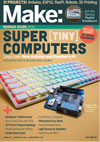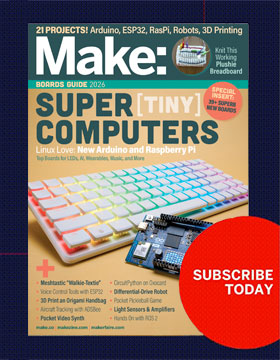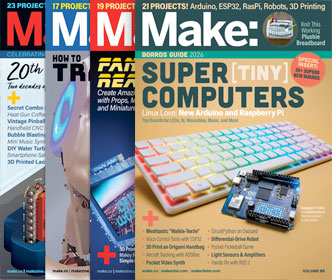
This past fall, Fry’s Home Electronics and Maker Shed (makershed.com) reached an agreement to install Maker Shed retail kiosks in four of Fry’s largest superstores as a kind of DIY retail test. Each kiosk was to merchandise MAKE magazine (natch), Make: Projects books, and a lineup of kits produced by some of our favorite indie makers like Mitch Altman, Ken Murphy, Dale Wheat, Amy Parness, and Ariel Churi.
Needless to say, we were elated. A big-box electronics store embracing DIY and the growing maker community! But this presented us with a bit of a challenge since we didn’t actually have any retail kiosks, or a budget to go buy anything. Plus, we started walking retail stores and quickly realized we don’t much care for most retail kiosks.
We wanted something that would effectively represent our magazines, books, kits, and the distinctive MAKE brand. It wasn’t enough to simply display product, we wanted to celebrate the maker spirit. It had to exude the familiar ambience of a shed, make maximum reuse of stuff we had sitting around the shop as well as locally salvaged materials, and fit in a 2’×2′ footprint. So after sketching up some ideas, we brought in local maker Joe Szuecs to make it all happen. Here he describes his process:
The Maker Shed team had some ideas regarding the design. From what I gathered, they were looking for a rustic workshop look. Mention was made of pegboard along with weathered corrugated galvanized steel. The early prototypes were built around the tubular aluminum framing used for Maker Faire workbenches.
I liked the idea of combining the modern look of the tubular aluminum with weathered natural materials. I’ve built furniture in the past using old corrugated steel roofing and weathered redwood fence boards. The materials work well together: think old barn. I threw together a prototype to see how it looked. The aluminum, redwood, and corru-gated steel combination completely evoked the spirit of MAKE. I envisioned a CNC whirring away in the middle of some unfinished garage space.
The functional components of the design were defined and sized. Now I needed to collect materials. I had a cache of reclaimed fence board in my workshop. But I needed more, so a visit was made to my source, a local fencing company that sells the fences they remove when installing new ones. I remembered a pile of corrugated metal sitting on a friend’s property. So I got a few sheets from him. The rest came from the usual sources.
Reclaimed fence board needs to be tamed a bit before use. A few passes through a planer evens out the thickness between boards. From there, it was just basic cabinetmaking: a solid interior structure of plywood, surfaced with the rustic materials.
The resulting kiosks are a nice combination of weathered shed and repurposed industrial tubing. They’re uniquely MAKE, and Fry’s is ecstatic. And in fittingly MAKE fashion, the kiosks were loaded up, trucked down, and set up by our own staffers Heather Cochran and Rob Bullington in one day.
If you’d like to check ’em out and maybe show Fry’s how much you appreciate the program by buying a thing or two, you can find them at the following California Fry’s stores: San Diego, San Jose (East Brokaw), Fremont, and Sunnyvale (East Arques). And hopefully, more locations and other electronics retailers will follow.
ADVERTISEMENT
Join Make: Community Today









